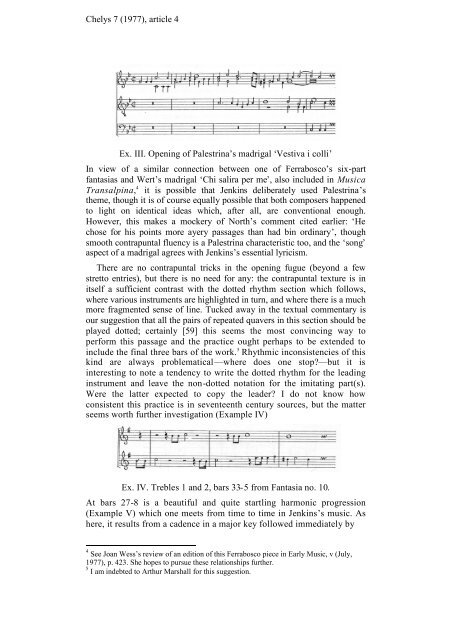download.pdf - 6.3Mb - Viola da Gamba Society
download.pdf - 6.3Mb - Viola da Gamba Society
download.pdf - 6.3Mb - Viola da Gamba Society
You also want an ePaper? Increase the reach of your titles
YUMPU automatically turns print PDFs into web optimized ePapers that Google loves.
Chelys 7 (1977), article 4<br />
Ex. III. Opening of Palestrina’s madrigal ‘Vestiva i colli’<br />
In view of a similar connection between one of Ferrabosco’s six-part<br />
fantasias and Wert’s madrigal ‘Chi salira per me’, also included in Musica<br />
Transalpina, 4 it is possible that Jenkins deliberately used Palestrina’s<br />
theme, though it is of course equally possible that both composers happened<br />
to light on identical ideas which, after all, are conventional enough.<br />
However, this makes a mockery of North’s comment cited earlier: ‘He<br />
chose for his points more ayery passages than had bin ordinary’, though<br />
smooth contrapuntal fluency is a Palestrina characteristic too, and the ‘song’<br />
aspect of a madrigal agrees with Jenkins’s essential lyricism.<br />
There are no contrapuntal tricks in the opening fugue (beyond a few<br />
stretto entries), but there is no need for any: the contrapuntal texture is in<br />
itself a sufficient contrast with the dotted rhythm section which follows,<br />
where various instruments are highlighted in turn, and where there is a much<br />
more fragmented sense of line. Tucked away in the textual commentary is<br />
our suggestion that all the pairs of repeated quavers in this section should be<br />
played dotted; certainly [59] this seems the most convincing way to<br />
perform this passage and the practice ought perhaps to be extended to<br />
include the final three bars of the work. 5 Rhythmic inconsistencies of this<br />
kind are always problematical—where does one stop?—but it is<br />
interesting to note a tendency to write the dotted rhythm for the leading<br />
instrument and leave the non-dotted notation for the imitating part(s).<br />
Were the latter expected to copy the leader? I do not know how<br />
consistent this practice is in seventeenth century sources, but the matter<br />
seems worth further investigation (Example IV)<br />
Ex. IV. Trebles 1 and 2, bars 33-5 from Fantasia no. 10.<br />
At bars 27-8 is a beautiful and quite startling harmonic progression<br />
(Example V) which one meets from time to time in Jenkins’s music. As<br />
here, it results from a cadence in a major key followed immediately by<br />
4 See Joan Wess’s review of an edition of this Ferrabosco piece in Early Music, v (July,<br />
1977), p. 423. She hopes to pursue these relationships further.<br />
5 I am indebted to Arthur Marshall for this suggestion.
















